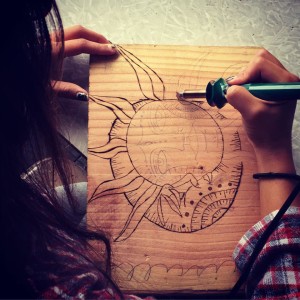Three Ways To Foster Creativity In Your Kids
Hello world,
Happy weekend! How are you all doing?
I’m feeling a bit creative today, but instead of creating something, I’ll talk about the actual concept of creativity, especially with kids.
Many people assume that creativity is something people are born with or aren’t. The assumption is that children are not equally creative, just as children are not equally intelligent. Contrary to this belief, creativity is not an inborn talent at all, but rather – a skill that can be honed and develop over time.

Teens Wood burning at the World City Center – partnered with Youthink Organization and Nani Nani Kids
Because creativity is essential to our success in life, it is one of the mst important core skills that you need to develop in your kids. Beofre thinking of sending your child to art or music class, it helps to understand that creativity isn’t limited to just arts and music. It plays an important role in other aspects like science, mathematics and even the way we deal with people.
Do you know that creative individuals are known to be better problem solvers? They are also more flexible and adapt easier to changes and development.
Research shows, though, that it’s important to start as early as possible – because children today are bombarded with experiences (TV shows, prefabricated characters, props, plots and more) that actually hinder creative development.
The good news is that you can actually foster and strengthen your child’s creativity at home – without you even trying that hard! Here are a few steps that you can incorporate into your daily routine easily, you won’t even notice that you’re trying.
1. Give kids time, among other resources, to express themselves creatively
Children need plenty of time for unstructured and imaginative play – without strict directions on what to do and what to follow. Let them do their own thing, and give them (which is the next important resource) space to do it. You don’t have to sacrifice cleanliness over creativity, because you can still keep your house clean by providing them a specific space where they can do their creative stuff – like an extra room or corner where they can play dress-up or paint.
Speaking of resources, buy toys or materials that foster creativity like art supplies, Legos, costumes, cameras and the like.
2. Give them freedom and autonomy
It is natural for parents to play the role of the boss telling kids to “do this” or “do that,” or keep them on the leash all the time, but give them the freedom and the autonomy to do what they want – within reasonable limits, of course. Let them color outside the lines, commit fashion mistakes by wearing plaid bottoms with striped tops or assemble a certain toy their way – even if it takes hours to complete!
Don’t be so quick to shoot their ideas and thoughts down the drain, too. Encourage them to think – and disagree with you and find solutions to problems their own ways.
3. Reduce the pressure on performance
Your child’s creativity isn’t about his or her performance on stage, or how he or she grades well on an exam. It is never really about who finished first or got the top grade, but the experience. Teach your kids to focus on the process instead of the result by reducing pressure to get the best outcomes and allowing them to enjoy the process.




